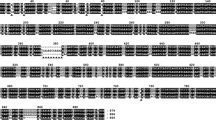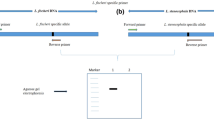Abstract
The traditional oriental medicine bokbunja, prepared from immature berries of Rubus coreanus is used as an anti-oxidant, diuretic, and cure for impotence. The bokbunja wine made from fermented fruits of bokbunja has been used as a functional food as well. However, the usage of bokbunja has been problematic over the years due to the abundance of mistakenly identified berries such as Rubus chingii, Rubus crataegifolius, and Rubus occidentalis. Thus, here we developed a method for the molecular differentiation of Rubus species as well as the authentication bokbunja from other Rubus species. We screened several sequences from the chloroplast DNA of these species and found that the rpl16 region was polymorphic for R. coreanus and R. occidentalis, while the trnG–trnS intergenic spacer region was polymorphic for R. chingii and R. crataegifolius. Species-specific primers were designed and a multiplex PCR was performed by combining the markers at the rpl16 and trnG–trnS regions. Amplicons of 686 bp for R. coreanus and 478 bp for R. occidentalis were produced by the primers 5′ Rcor or 5′ Rocci, respectively, with 3′ rpl16; whereas, amplicons of 389 bp for Rubus crataegifolius and 180 bp for R. chingii were produced by 5′ Rcra or 5′ trnG–trnS, respectively, and 3′ Rcra/Rchi. The deduced molecular markers were utilized to authenticate the bokbunja products and demonstrated that the majority of bokbunja samples from the markets were adulterant berries. Hence, our results indicate that the produced molecular markers can serve as an effective tool to authenticate bokbunja.





Similar content being viewed by others
References
Corpet F (1988) Multiple sequence alignment with hierarchical clustering. Nucleic Acids Res 16(22):10881–10890
Dong XL, Tang HR, Li L, Wong XR, Duan J, Chen Q (2009) Genetic diversity of 18 bramble cultivars introduced abroad and 8 wild materials of Rubus coreanus from china revealed by RAPD. J Mol Genet 1(1):1–6
Dong W, Liu H, Xu C, Zuo Y, Chen Z, Zhou S (2014) A chloroplast genomic strategy for designing taxon specific DNA mini-barcodes: a case study on ginsengs. BMC Genet 15:138
Eu GS, Park MR, Yun SJ (2009) Internal transcribed spacer (ITS) regions reveals phylogenic relationships of rubus species cultivated in Korea. Korean J Med Crop Sci 17(3):165–172
Hall T (2011) BioEdit: an important software for molecular biology. GERF Bull Biosci 2:60–61
He Y, Jin S, Ma Z, Zhao J, Yang Q, Zhang Q, Zhao Y, Yao B (2018) The antioxidant compounds isolated from the fruits of chinese wild raspberry Rubus Chingii Hu. Nat Prod Res. https://doi.org/10.1080/14786419.2018.1504046
Kim EH (2010) Rubus pharmacology: antiquity to the present. Hort Sci 45(11):1587–1591. https://doi.org/10.21273/HORTSCI.45.11.1587
Kim HH, Choi PH, Yoo JS, Jeon H, Chae BS, Park JS, Kim SH, Shin TY (2012) Ripe fruit of Rubus coreanus inhibits mast cell-mediated allergic inflammation. Int J Mol Med 29(2):303–310. https://doi.org/10.3892/ijmm.2011.829
Kim Y, Lee SM, Kim JH (2014) Unripe Rubus coreanus Miquel suppresses migration and invasion of human prostate cancer cells by reducing matrix metalloproteinase expression. Biosci Biotechnol Biochem 78:1402–1411
Kim MK, Choi HS, Cho SG, Shin YC, Ko SG (2016) Rubus coreanus Miquel extract causes apoptosis of doxorubicin-resistant NCI/ADR-RES ovarian cancer cells via JNK phosphorylation. Mol Med Rep 13:4065–4072
Kula M, Krauze-Baranowska M (2016) Rubus occidentalis: the black raspberry—its potential in the prevention of cancer. Nutr Cancer 68:18–28
Lee JM (2015) Analysis of bokbunja products show they contain Rubus occidentalis L. fruit. J Funct Foods 12:144–149
Lee JW, Lee IS (2008) Effects of Rubus coreanus Miquel extracts on the proliferation and differentiation of mouse osteoblast-like MC3T3-E1 cells. J Food Drug Anal 16:80–87
Lee J, Dossett M, Finn CE (2013) Anthocyanin fingerprinting of true bokbunja (Rubus coreanus Miq.) fruit. J Funct Foods 5:1985–1990
Lee J, Dossett M, Finn CE (2014) Mistaken identity: clarification of Rubus coreanus Miquel (Bokbunja). Molecules 19:10524–10533
Lee JH, Bae SY, Oh M, Seok JH, Kim S, Chung YB, Gowda KG, Mun JY, Chung MS, Kim KH (2016) Antiviral effects of black raspberry (Rubus coreanus) seed extract and its polyphenolic compounds on norovirus surrogates. Biosci Biotechnol Biochem 80:1196–1204
Liu T, Hua S, Wang Z (2015) Rubus chingii 覆盆子 (Fupenzi, Immature Raspberry fruit). In: Liu Y, Wang Z, Zang J (eds) Dietary chinese herbs: chemistry, pharmacology and clinical evidence. Springer, Vienna, pp 509–517
Moon KM, Kim JE, Kim HY, Lee JS, Son GA, Nam SW, Kim BW, Lee JH (2011) Antioxidant activity of Rubus crataegifolius Bge. Fruit extracts. J Life Sci 21:1214–1218
Oh DR, Kim YJ, Choi EJ, Lee H, Jung MA, Bae D, Jo A, Kim YR, Kim S (2016) Antiobesity effects of unripe Rubus coreanus Miquel and its constituents: an in vitro and in vivo characterization of the underlying mechanism. Evid Based Complement Alternat Med 2016:4357656
Park HL, Lee HS, Shin BC, Liu JP, Shang Q, Yamashita H, Lim B (2012) Traditional medicine in china, Korea, and Japan: a brief introduction and comparison. Evid Based Complement Alternat Med 2012:429103
Seeram NP (2008) Berry fruits: compositional elements, biochemical activities, and the impact of their intake on human health, performance, and disease. J Agric Food Chem 13:627–629
Shi J, Ye X, Jiang B, Ma Y, Liu D, Xue SJ (2010) Traditional medicinal wines. In: Shi J, Ho CT, Shahidi F (eds) Functional foods of the east. CRC Press, Boca Raton, pp 417–430
Wang Y, Chen Q, Chen T, Tang H, Liu L, Wang X (2016) Phylogenetic insights into Chinese Rubus (Rosaceae) from multiple chloroplast and nuclear DNAs. Front Plant Sci 7:968
Yang JW, Choi IS (2016) Comparison of the phenolic composition and antioxidant activity of Korean black raspberry, Bokbunja (Rubus coreanus Miquel) with those of six other berries. CyTA J Food 15:110–117
Yang JYJS, Kim HK, Park SJ, Kim HK, Park SJ (2012) Development of a molecular marker to discriminate Korean Rubus species medicinal plants based on the nuclear ribosomal DNA internal transcribed spacer and chloroplast trnL-F intergenic region sequences. J Korean Soc Appl Biol Chem 55:281–289
Yoon HJ, Kim CS, Lee KY, Yang SY (2010) Antioxidant activity of Rubus coreanus fruit extract: in comparison to green tea extract. Chonnam Med J 46:148
Zhang Y, Iaffaldano BJ, Zhuang X, Cardina J, Cornish K (2017) Chloroplast genome resources and molecular markers differentiate rubber dandelion species from weedy relatives. BMC Plant Biol 17(1):34. https://doi.org/10.1186/s12870-016-0967-1
Acknowledgements
This research was supported by the Korea Institute of Planning and Evaluation for Technology in Food, Agriculture, Forestry and Fisheries (KIPET 31700-3), Republic of Korea.
Author information
Authors and Affiliations
Corresponding author
Ethics declarations
Conflicts of interest
The authors declare that they have no conflict of interest.
Additional information
Publisher's Note
Springer Nature remains neutral with regard to jurisdictional claims in published maps and institutional affiliations.
Electronic supplementary material
Below is the link to the electronic supplementary material.
Fig. S1
Validation of SNP makers using bokbunja samples procured from local markets in Korea. The asterisk indicates the band specific to R. coreanus. (PPTX 1284 kb)
Rights and permissions
About this article
Cite this article
Mohanan, P., Hurh, J., Kim, S.O. et al. Chloroplast DNA-derived markers for the authentication of oriental medicinal Rubus species and mistaken identity of bokbunja in the local markets of Korea. Plant Biotechnol Rep 13, 305–314 (2019). https://doi.org/10.1007/s11816-019-00540-5
Received:
Accepted:
Published:
Issue Date:
DOI: https://doi.org/10.1007/s11816-019-00540-5




